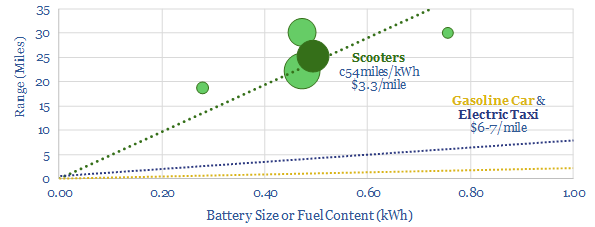E-scooters can transform urban mobility, eliminating 2Mbpd of oil demand by 2030, competing amidst the ascent of “electric vehicles” and re-shaping urban economies. These implications follow from e-scooters having 25-50x higher energy efficiencies, higher convenience and c50% lower costs than gasoline vehicles, over short 1-2 mile journeys. Our 12-page note explores the consequences.
Page 2 charts the meteoric ascent of e-scooters. In their first year of deployment, they matched the peak growth rate of taxi-apps (e.g., Uber) and overtook ride-sharing bicycles which have been under commercialisation for quarter-of-a-century.
Page 3 assesses the leading companies, all of which launched in late-2017 or early-2018, and have since raised $1.5bn.
Pages 4-5 compares the energy-economics of electric scooters with fourteen other vehicle concepts, explaining the physics of e-scooters’ 25-50x higher efficiencies.
Page 6 compares the relative benefits of e-scooters versus electric cars, which are clearest when comparing the relative strain on grid infrastructure.
Pages 7-8 show how e-scooters displace oil demand, outlining our projections for 2Mbpd of demand destruction globally by 2030. This oil demand is not “replaced” by electricity demand. c95-98% of it is simply eliminated.
Pages 9-11 model the per-mile costs of e-scooters, as a function of multiple input variables, showing the most competitive contexts relative to cars and taxis.
Page 12 ends by exploring potential consequences for urban economies. Most of all, we expect economic growth to be supported, particularly for retail; conversely e-mobility may embolden policymakers to ban gasoline vehicles from cities.

